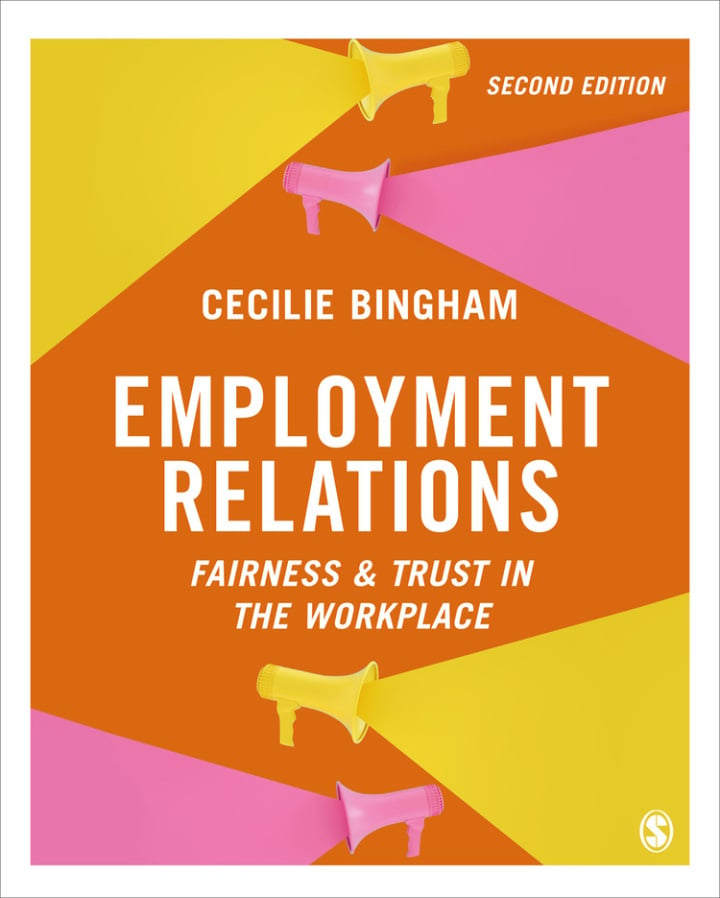
Employment Relations 2nd Edition - Fairness and Trust in the Workplace
PUBLISHER: Sage
Trường ĐH, Nhóm, Thư Viện: Gọi 0915920514 để báo giá eBook hosting trên Vital Source hoặc mua Sách In
Quan hệ việc làmSự công bằng và tin cậy ở nơi làm việcPhù hợp với kết quả học tập của CIPD, Quan hệ Việc làm: Sự công bằng và Tin cậy tại Nơi làm việc (ấn bản thứ hai) phản ánh sâu sắc về nghiên cứu, bình luận, bằng chứng và thực tiễn hiện tại trong lĩnh vực quan hệ việc làm với cách tiếp cận quốc tế và tập trung vào toàn cầu hóa. Kết hợp các khái niệm, công cụ và mô hình lý thuyết với các ví dụ thực tế, cuốn sách này có nhiều tính năng học tập sáng tạo được thiết kế để giúp sinh viên tương tác với chủ đề, bao gồm: Trích đoạn các tin tức gần đây liên quan đến nội dung chương Một loạt nghiên cứu điển hình từ nhiều bối cảnh khác nhau, hoạt động và bài tập ôn tập Cuốn sách được khen ngợi bởi nguồn tài liệu của giảng viên, bao gồm sổ tay hướng dẫn toàn diện và các slide PowerPoint. Thích hợp cho sinh viên Đại học và Sau đại học về các khóa học Quan hệ Việc làm, Quan hệ Công nghiệp hoặc Quản lý nhân sự.
List of Case Studies, Case Snippets and News FlashesGuided TourOnline ResourcesAbout the AuthorAcknowledgementsAbout this Book1 Employee Relations: Setting the SceneWhat to ExpectEmployee Relations – What Is It?Changes in the UK Employment MarketHuman Resource Management (HRM)Power ImbalancesFrames of ReferenceManagerial StylesSummaryRelevant Articles for Further ReadingReferences2 Employee Relations: The Importance of ContextWhat to ExpectContext – Is It Relevant?Globalisation and Employment RelationsConvergence Versus DivergenceTrade UnionsSummaryRelevant Articles for Further ReadingReferences3 Trust and Getting a Fair Deal at WorkWhat to ExpectTrust at WorkFairness and TrustFairness and the LawEquity, Efficiency and VoiceEmployee Perceptions of Organisational Fairness, Justice and InjusticePsychological ContractIncreased Workloads and Levels of TrustTrust and the High-performing WorkplaceSummaryRelevant Articles for Further ReadingReferences4 Contract Change and the Employment RelationshipWhat to ExpectWhat Is an Employment Contract?What’s in a Name?Employment Contracts and the Power Realities of the Employment RelationshipSummaryRelevant Articles for Further ReadingReferences5 Employment Relations in Precarious Platform and Gig WorkWhat to ExpectPlatforms and Gigs ExplainedPrecarious WorkInsecurity and Platform WorkPlatform WorkDifferent Types of Platform WorkLegislationThe Impact of Algorithms on the Employment RelationshipPlatform Work, Power and Worker RepresentationSummaryRelevant Articles for Further ReadingReferences6 Causes and Expressions of Workplace ConflictWhat to ExpectThe Causes and Inevitability of Workplace ConflictAcademic Perspectives on ConflictExpressions of ConflictSummaryRelevant Articles for Further ReadingReferences7 Conflict: Reduction, Regulation and ResolutionWhat to ExpectA Contested Relationship: Managerial Styles and Their ImpactConflict and Performance ManagementConflict Reduction and Strategies Engendering Employee TrustAddressing ConflictRestrictions on Employers That Could Reduce the Incidence of ConflictExamples of Legal Restrictions to Reduce ConflictProcedures and Their Impact on the Employment RelationshipTypes of ProceduresAlternative Dispute ResolutionSummaryRelevant Articles for Further ReadingReferences8 Employee Engagement and the Employment RelationshipWhat to ExpectWhat Is Employee Engagement?The Engagement ParadoxMeasures of EngagementEngagement and the Employment RelationshipEngagement Trust and VoiceSummaryRelevant Articles for Further ReadingReferences9 Sharing Information and Decision-Making: From Employee Involvement to PartnershipWhat to ExpectEncouraging Commitment Through Involvement and ParticipationEmployee Involvement, Participation and PartnershipWhat Do Employee Involvement, Participation and Partnership Entail?Employee InvolvementEmployee NetworksEmployee ParticipationCategorising ParticipationPartnershipSummaryRelevant Articles for Further ReadingReferences10 Employee Voice: Being Heard and Making a DifferenceWhat to ExpectVoice – Definitions and Their ShortcomingsEvidence for the Concept of Employee Voice Within the Employment RelationshipEmployer VoicePatterns of VoiceDirect VoiceIndirect VoiceCollective BargainingNational v. Local AgreementsCollective Bargaining ModelsEnabling Voice – UK Employers’ Legal ObligationsVoice and SilenceVoice and DiversityVoice, Trust and FairnessSummaryRelevant Articles for Further ReadingReferences11 Flexibility and Fairness in the Employment RelationshipWhat to ExpectFlexible Work Patterns: What Are They and Who Benefits?Flexibility for the EmployeeManagerial Styles and Flexibility From the Employers’ Point of ViewFlexible Working and Pluralist ApproachesThe Flexible FirmDifferent Types of Flexible Working PatternsFlexibility: Gender and Family-friendly PracticesFlexibility: Power, Conflict and TrustFlexibility: Points to Consider for Maintaining an Harmonious Employment RelationshipSummaryRelevant Articles for Further ReadingReferences12 Equitable Reward and the Employment RelationshipWhat to ExpectThe Value of Reward in the WorkplaceEmployers and RewardInfluences Affecting RewardConsensual Methods of Determining RewardReward and Perceptions of FairnessDifferent Types of Payment SystemsSummaryRelevant Articles for Further ReadingReferences13 Fairness in PracticeWhat to ExpectFairness in ContextFairness and PowerFairness and Justice at Work: A RecapInjustice, Justice and ConflictVoice Mechanisms and the Perceptions of FairnessHolding the Front Line Via Fairness: The Importance of Line ManagersRelevant Articles for Further ReadingReferencesGlossaryIndex















